Bringing the show to life
With so many digital images vying to grab our attention, moving or changing images and interactive options have become increasingly important, as our desire not only to see and hear, but touch, be involved with, and even become part of a display has grown massively over the past few years. Markets for the technology now encompass leisure destinations, hotels, museums, and galleries, as well as advertising and point-of-sale (POS).
Whatever the environment, however, two key pieces of hardware in bringing the show to life are the screen and the multimedia player.
Touching experiences
How many of us as children could resist pressing a button to see a mechanical display, electronic effect, or just to watch a tiny train run round a miniature track? It was magic, and that wonder has remained, translated now into digital format. As digital solutions continue to enhance the consumer experience with the increasing use of tablets, POS and kiosks, interactive signage is now emerging as the technology that delivers a new kind of customer engagement and interaction.
“Interactive solutions do not simply display pictures, they convey what is behind a brand while creating up-selling and cross-selling opportunities,” explains Raj Parmar, marketing director of Box Technologies, adding: “It means a touch of the screen provides access to all kinds of content, including customer testimonials and promotions, and captures completely new audiences in fresh ways. And it works exceptionally well in retail, banks, post-offices, supermarkets, showrooms, and similar environments.”

Interactive solutions do not simply display pictures, they convey what is behind a brand while creating up-selling and cross-selling opportunities”
Demonstrating Parmar’s point is an installation created by Box Technologies for Watches of Switzerland, where interactive digital displays were created in its spectacular flagship London venue for 20 of the best known and most admired Swiss watch manufacturers. All of the displays were designed to educate and entertain customers throughout all three floors of the store on Regent Street.
“The centrepiece of our Cielo Interactive Solution is the 3 x 2m touch screen that enables customers, staff, or both together, to discover each of the very distinct brands and individual watches,” notes Parmar.
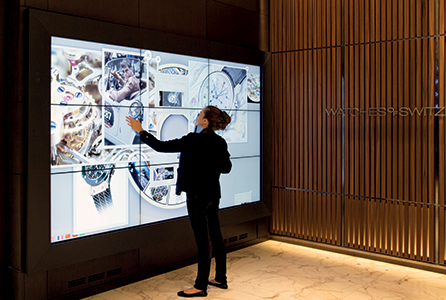
The centrepiece of Box Technologies’ Cielo Interactive Solution for Watches of Switzerland is the 3 x 2m touchscreen that enables customers and staff to discover each of the 20 best known Swiss watch brands and individual watches
By rotating or touching the main timepiece graphic, it is possible for a customer to explore the workings of a particular watch, with images expanding, contracting or moving with a touch of the screen.
Parmar concludes: “In fact, customers can examine scores of interactive watch graphics and a single touch allows the language to change to include multiple nationalities.”
Meanwhile, a specialist in display solutions, Hampshire-based Fairfield Displays is set to launch an all-in-one touchscreen onto the market. Supplied with its own integrated PC, the unit runs as standard with Windows and Android operating systems, with built-in Wi-Fi, and all users need to add is a Windows licence. The screen comes with the state-of-the-art projected capacitive interactive technology, which is not affected by dust or debris on the screen surface, and can handle up to ten touch points, which allows a variety of applications.
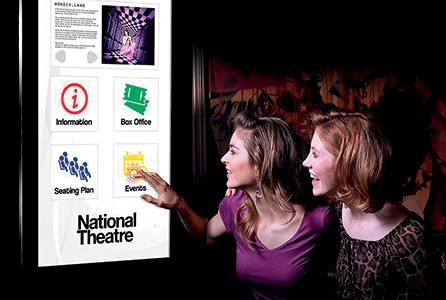
With the new all-in-one touchscreen from Fairfield Displays, users can zoom in and out, as well as perform multiple touch gestures, in the same way as using a domestic tablet
Janice Fairfield, marketing director at Fairfield Displays, comments: “You can zoom in and out as well as perform multiple touch gestures like you would use on a domestic tablet. Units are available from 22 up to 42? (55.9 x 106.7cm) and can be considered as the largest commercial tablet on the market. And for screens that will be positioned in a window, the new expanded range of Sunlight Readable Screens is a must as they will be clearly visible even under bright sunlight.”
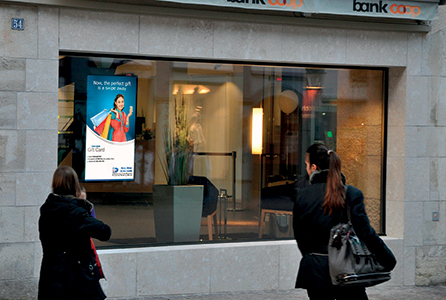
The new expanded range of Sunlight Readable Screens from Fairfield Displays are 1,500cd/m², which is three times brighter than standard commercial screens, making them clearly visible even under bright sunlight
These units are 1,500 cd/m², which is three times brighter than standard commercial screens. Units can be used as media players with built-in scheduling systems, or networked. Models are available from 32 up to 55? (81.3 up to 139.8cm) and include the 55? free-standing unit.
A clearer picture
Crystal Display Systems, a designer, distributor, and reseller of flat panel display solutions, is constantly adding unique and innovative digital displays to its product range. Managing director, Chris Bartram comments: “As the digital signage industry evolves so too do the products CDS has to offer, so we are constantly providing our customers with the most exciting and revolutionary display products the market has to offer.”
One of the products Crystal Display Systems specialises in is its transparent state-of-the-art ClearVue showcase displays, which allow a product to be placed inside a showcase box, and then digital advertising content is run on the high resolution transparent LCD in front to grab attention, help promote, and ultimately sell the product and create the ‘wow’ factor.
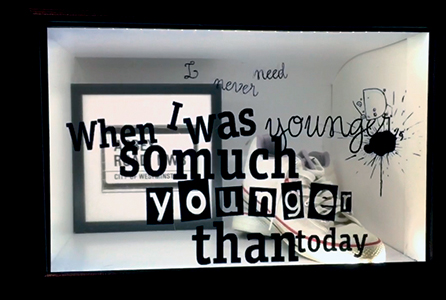
Crystal Display Systems’ transparent state-of-the-art ClearVue showcase allows a product to be displayed inside the showcase box, while digital advertising content is run on the high resolutions transparent LCD in front
Bartram observes: “As the technology has improved, it is taking the retail sector by storm as they successfully give that unique advertising spark which retailers and designers alike crave. The industry has evolved from using just paper-type signage to digital, and now this is taking it to the next level where you combine that digital display with the actual product inside a showcase box.”

This is taking it to the next level where you combine digital display with the actual product inside a showcase box”
Crystal Display Systems has now seen installs for Harrods, Nike, Casio, Adidas, Watches of Switzerland, and Rolex, to name a few with their very own standard models, or assisting their customers with custom designs. With online shopping booming, and the need for the retail sector to become ever more innovative in order to entice customers in-store, designers and end-users can now benefit from Crystal Display Systems’ new transparent LED window displays.
Speaking about the solution, Bartram says: “This product has completely changed the face of window advertising and opens up so many exciting opportunities for integrators. Visual impact is amazing as for the first time stores and brands can show these amazing images and messages without blocking the view to their stores where they spend a lot of money to make them bright and inviting.”
Playing to the gallery
Most people stopping to look at, or interacting with, digital signage will give even a passing thought to what is driving it and yet the media player is one of the fundamental elements in bringing the whole thing to life. AV Stumpfl is an award-winning Austrian company that designs, manufactures, and markets a range of high-performance mobile and installation projection screens, multi-display, and show control systems for professional and business applications.
A recent addition to the company’s product portfolio is the AV Stumpfl solid-state FHD Player. Compact and rugged, the FHD Player can be synchronised via Ethernet, externally controlled from any location, and can even trigger media based on GPS input coordinates.
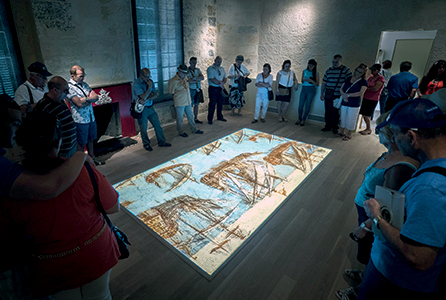
Integration experts Sarner created and installed a vast array of 700 graphics panels and content for over 100 audiovisual productions at the new National War Museum in Malta, with AV Stumpfl players configured to display content onto the screens. Image copyright © Sarner
Fred Neulinger, technical director at AV Stumpfl, comments: “AV Stumpfl is known to be first in introducing the industry’s most innovative and functional products, and our FHD Player continues that tradition. The real user benefit lies in the deployment of our newly developed synchronisation that’s designed to give users plug-and-play performance and letting users focus on getting other parts of the installation right."
Already utilised in a wealth of real-time graphics-intensive applications such as corporate AV, museums, themed and visitor attractions, and digital signage, the FHD Player can be synchronised using a dedicated computer protocol eliminating redundancy. A seamless loop mode and transition fading between clips ensures that video is shown automatically, every time.
Management of media is possible regardless of geographic boundaries. Automatic content triggering is based on location and positioning. For example, the player can be deployed as part of a local tourist guide system on ships, buses, or transport.
O Factoid: Whilst many digital signage technologies date back to the early 1970s or even earlier, the modern history of digital signage is generally traced back to the automated teller machine (ATM), introduced in the late 1970s. O
Among the range of additional benefits are the ability to load and download content automatically; playback and scheduling can be configured according to a calendar using a dynamic front-end graphical user interface, and configuration and maintenance of the FHD Player is achieved in an instant using customisable menus. Designed for 24/7 operation, the unit comes with automatic restore and hot swap capability.
FHD Players can be integrated into the AV Stumpfl Avio network and interactively controlled by proximity sensors, gesture detection, tracking, push buttons or light barriers. In addition, signal management is intuitive as the player will read the EDID of the connected device or create its own output signal specified by resolution and refresh rate.
The sleek matt black Austrian designed hardware weighs just 620g and its tiny footprint measures just 205 x 122 x 29mm.
Neulinger concludes: “Adding to complete return on investment, the player is future proof through the free feature updates from the AV Stumpfl website and is backed by AV Stumpfl’s unmatched global service and support. The functionality of our FHD Player ensures endless creativity with media management.”
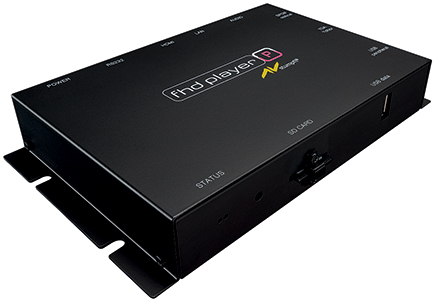
AV Stumpfl’s solid-state FHD Player is compact and rugged and can be synchronised via Ethernet, externally controlled from any location, and can even trigger media based on GPS input coordinates
A prime example of the implementation of AV Stumpfl digital display technology can be found at the new National War Museum in Malta. In what the company describes as one of the most compelling and exciting installations of multimedia technology to date, integration experts, Sarner created and installed a vast array of 700 graphics panels and content for over 100 audio-visual productions. Sarner worked with design consultants, Forward Architects Joint Venture and main contractor Camray to bring the project to life.
Speaking about the project, Ross Magri, managing director at Sarner, comments: “AV Stumpfl players are configured to display our content onto the screen. We remotely access the servers to update as necessary using a FTP server, or if there is a particular event or archaeological discovery made.”
Each player loops all data and multimedia-based content created by Sarner that is frame synchronised, ensuring failsafe presentations when they are switched on in the morning until the Museum closes. As visitors walk through the museum, they are told the stories of the people, battles, and ages in chronological order using visual displays and interactive elements.
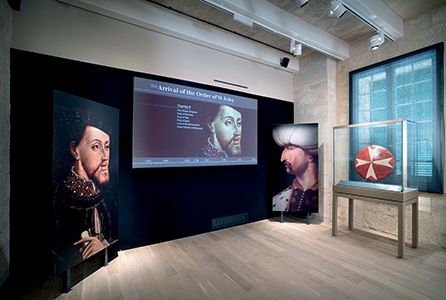
As visitors walk through the National War Museum in Malta they are told the stories of the people, battles and ages in chronological order using visual displays and interactive elements. Image copyright © Sarner
Magri adds: “A highlight of this brand new attraction is undoubtedly the immersive show, set inside the historic Cavalier, propelling visitors into the heart of these experiences. Here, a Wings Engine Play is used to manage content over three projection areas.”
Wings Engine Play is an industrial standard hardware platform that uses AV Stumpfl automatic camera based alignment calibration and has sophisticated production and show control capabilities. And it is ironic that sysems like this come in small black boxes, as the direction that digital signage will take next will surely be the result of ‘outside the box’ thinking by innovative creative minds. However, what is inside the boxes—the screens, players, and drivers—will remain fundamental to its realisation.
Your text here...